
Water | Resources
Holland Bowl Mill
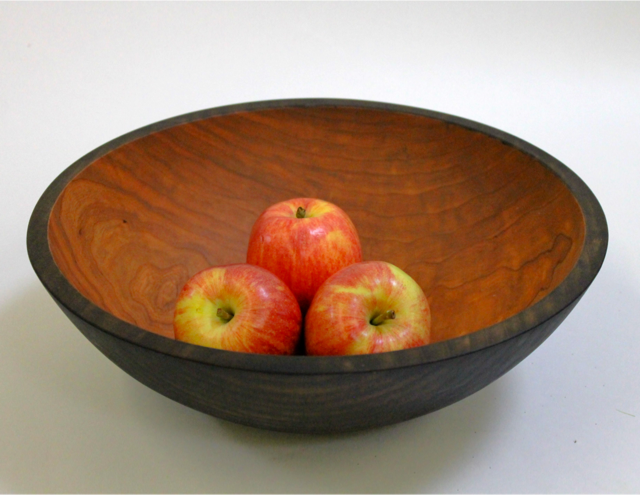 Wooden bowls of all sizes, made from a variety of different woods. They also have a unique treatment for the wood called “ebonizing” which is the use of a vinegar and iron solution that turns the wood black. These bowls are quite beautiful with black on the outside and the natural wood on the inside. They also make a whole series of nesting bowls from one block of wood. You can special order a whole set of these nested bowls if you want, though it’s not an item on the website. Bowls are finished with food grade mineral oil, but you can also order them unfinished. They also make live edge bowls!
Wooden bowls of all sizes, made from a variety of different woods. They also have a unique treatment for the wood called “ebonizing” which is the use of a vinegar and iron solution that turns the wood black. These bowls are quite beautiful with black on the outside and the natural wood on the inside. They also make a whole series of nesting bowls from one block of wood. You can special order a whole set of these nested bowls if you want, though it’s not an item on the website. Bowls are finished with food grade mineral oil, but you can also order them unfinished. They also make live edge bowls!
Masontops
 Great lids for your Mason jars to make them more useful. Chalk Tops let you label and relabel the lids, Timber Tops let you top your jars with bamboo wood instead of metal, and then there are all kinds of tools and instructions for fermenting vegetables in your Mason jars.
Great lids for your Mason jars to make them more useful. Chalk Tops let you label and relabel the lids, Timber Tops let you top your jars with bamboo wood instead of metal, and then there are all kinds of tools and instructions for fermenting vegetables in your Mason jars.
Earth Stix
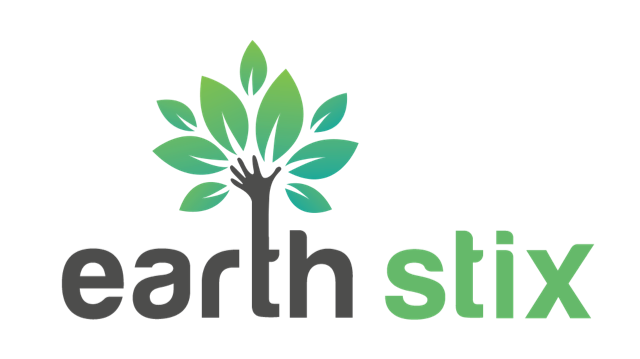 Disposable wooden cutlery made from all natural birch wood. “Our stylish and sustainable Earth Stix are the perfect fit for use at parties, campouts, weddings, and the like. Earth Stix can be used for traveling, packed meals, picnics, and more. ”
Disposable wooden cutlery made from all natural birch wood. “Our stylish and sustainable Earth Stix are the perfect fit for use at parties, campouts, weddings, and the like. Earth Stix can be used for traveling, packed meals, picnics, and more. ”
Unfinished Furniture Expo
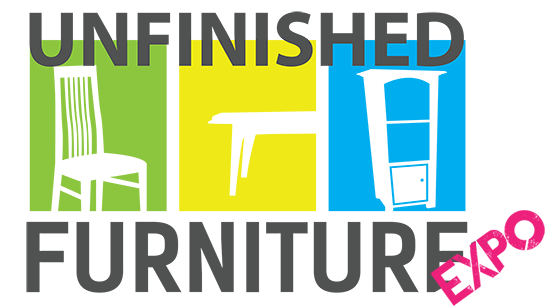 Unfinished furniture in more styles than I usually see on unfinished furniture websites. Check this site to find something different. Search by type of furniture and also by style. “At Unfinished Furniture Expo, you can find an assortment of furniture pieces, all made with a variety of wood. The pieces include tables, table pedestals, table tops, chairs, dining tables, coffee tables, kitchen furniture, beds, headboards, entertainment centers, desks, bookcases, bookshelves, and even chairs and tables for children. These pieces can be found in alder, birch, pine, parawood, and oak. We offer all of our pieces as discounted unfinished furniture, inclusive of free shipping on orders over $39.”
Unfinished furniture in more styles than I usually see on unfinished furniture websites. Check this site to find something different. Search by type of furniture and also by style. “At Unfinished Furniture Expo, you can find an assortment of furniture pieces, all made with a variety of wood. The pieces include tables, table pedestals, table tops, chairs, dining tables, coffee tables, kitchen furniture, beds, headboards, entertainment centers, desks, bookcases, bookshelves, and even chairs and tables for children. These pieces can be found in alder, birch, pine, parawood, and oak. We offer all of our pieces as discounted unfinished furniture, inclusive of free shipping on orders over $39.”
Organic Mattress encasement for Dust Mites

Question from Sherry
Hi Debra,
Per your recommendation, I have purchased a Naturepedic mattress and want to find a mattress encasement to protect the mattress and prevent dust mites. Can you please recommend a mattress encasement.
I see that Naturepedic offers a waterproof mattress pad, but it does not encase the entire mattress. Also, I can concerned about the Naturepedic mattress protector because it has a layer of polyurethane for its waterproofing. I have recently learned that polyurethane foam is toxic and am in the process of trying to remove it from my house. Should I be concerned about the polyurethane in Naturepedic’s mattress pad? Thank you again for all of your help and support! You are an inspiration!
Debra’s Answer
Polyurethane itself is NOT toxic, polyurethane FOAM is toxic because of other chemicals added to it to make foam and to make it fireproof. So no problem with the very thin membrane of polyurethane in Naturepedic’s mattress protector pad.
Here are some recommendations for mattress encasements that protect against dust mites. They are not waterproof.
THE CLEAN BEDROOM Organic Cotton Dust Mite Mattress Encasement
JANICE’S Organic Cotton Barrier Cloth Mattress Covers
JANICE’S Organic Cotton Mattress Covers
Toxicity of 3D Printing

You may have heard of a new type of printing called “three-dimensional (3D) printing.” Instead of printing ink on a piece of paper or plastic, the 3D printer actually makes a three-dimensional object. These printers are now available for home computers (starting at only $283), so you can now manufacture virtually any shape for any use right in your own home.
When I first saw this on TV several years ago, once I got over my disbelief my first question was, “What material are they using to make these objects and is it toxic?
Recently others have been asking this question too, and there is starting to be some research results to look at.
The majority of desktop 3D printers designed for the consumer market use a technology called fused filament fabrication (FFF), also known as molten polymer deposition (which sounds more descriptive to me). In this process, a slender thread of solid thermoplastic is melted and deposited in thin layers onto a moving bed. The three-dimensional solid shape is formed layer-by-layer as the plastic material cools and hardens. That makes logical sense to me, but the first time I saw it, it looked like magic.
A wide variety of filament materials are now being used in desktop FFF 3D printers, including
- acrylonitrile butadiene styrene (ABS)
- poly(lactic acid) (PLA)
- poly(vinyl alcohol) (PVA)
- polycarbonate (PC)
- high-density polyethylene (HDPE)
- high-impact polystyrene (HIPS)
- nylon
- and many other polymers, metals, ceramics, and other materials.
Filaments are melted at a variety of extruder nozzle temperatures and bed temperatures, and manufacturers typically recommend ranges of optimal temperatures for each filament material and thickness. These varying temperatures affect the amount of volatile organic chemicals (VOCs) and particles that might be released from the materials as well as their toxicity.
Two studies have generated quite a lot of data on this subject, which I’m not going to attempt to summarize here.
I just do want to mention that one study identified gasses that were released, which included ammonia, cyanidric acid, phenol, and benzene, among others.
Overall, lab tests showed that ABS is significantly more toxic than PLA, but the corn-based PLA had it’s own emissions when extruded at temperatures higher than 392 degrees F. This is important to note because there are many finished consumer products made from PLA that would not have emissions because they are at room temperature.
It was also noted that the same material spools, when acquired from different resellers, release very different quantities of VOCs, even if used in the same 3D printer and under the same parameters of speed and temperature. So there is a wide variation of air pollutants that could be present as the result of using a 3D printer.
Health effects mentioned were pulmonary problems, such as bronchitis, tracheitis, and asthma. In some cases, outgassing substances were known cause certain types of cancers.
Researchers recommend using 3D printers in a well-ventilated area.
3D PRINTING INDUSTRY: How Toxic are ABS & PLA Fumes?
3D PRINTING INDUSTRY: Gas evolution during FDM 3D printing and health impact
Color Kitchen
 “Naturally vibrant food colors…artificial dye-free, plant-based, vegan, gluten-free, and non-GMO,” developed by a woman who has long suffered from food allergies and chemical additives in products.
“Naturally vibrant food colors…artificial dye-free, plant-based, vegan, gluten-free, and non-GMO,” developed by a woman who has long suffered from food allergies and chemical additives in products.
Glob Color
 “Artists have been using fruit, vegetable, and herb pigments to mix paint since ancient times. Glob channels that age-old method with vibrant paints that yield bright and beautiful colors when mixed with water.” Watercolor paints and non-nano face paint. Watercolor and face paints make with plant pigments. ” Glob paints are made from food-grade ingredients, so they are as safe as possible for little ones to play with.” They also sell ColorKitchen “naturally vibrant food colors…artificial dye-free, plant-based, vegan, gluten-free, and non-GMO,” developed by the same woman.
“Artists have been using fruit, vegetable, and herb pigments to mix paint since ancient times. Glob channels that age-old method with vibrant paints that yield bright and beautiful colors when mixed with water.” Watercolor paints and non-nano face paint. Watercolor and face paints make with plant pigments. ” Glob paints are made from food-grade ingredients, so they are as safe as possible for little ones to play with.” They also sell ColorKitchen “naturally vibrant food colors…artificial dye-free, plant-based, vegan, gluten-free, and non-GMO,” developed by the same woman.
Eco-Kids
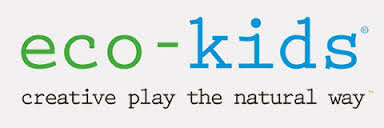 A family run business that produces
A family run business that produces
a line of art supplies that gives children the tools to create using non-toxic, natural ingredients and environmentally friendly packaging. Eco-dough, eco-finger paint, eco-egg coloring, eco-crayons and more are made from all natural ingredients. Dyes are FDA-approved natural dye. Paints are colored with natural and organic fruit, plant and vegetable extracts from annatto seed, blue shade vegetable, curcumin, purple sweet potato, red cabbage, rice flour, earth clay. These products are sold in many stores as well as online.
Filana Organic Beeswax Crayons
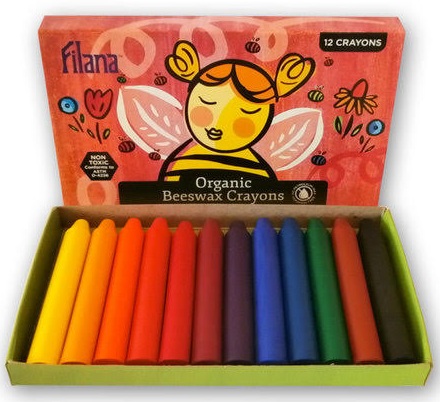 “Awesome crayons” made with “lots of organic beeswax…Filana™ crayons are made with natural waxes and over 25% certified organic beeswax. We never use petroleum waxes or paraffin. All our ingredients are GMO free. Filana™ crayons contain a special blend of organic and natural petroleum-free waxes, FDA-approved organic and inorganic pigments, and kaolin clay. Filana™ crayons conform to ASTM D-4236 standard, which indicates Filana™ crayons are certified nontoxic and meet or exceed specific quality standards. Filana™ crayons are CPSIA compliant. They have been tested by an independent laboratory and are certified to be compliant with the the CPSIA (Consumer Product Safety Improvement Act). Each one of our crayons is hand-crafted in Langley, Washington. Our crayons are 100% made in the US.”
“Awesome crayons” made with “lots of organic beeswax…Filana™ crayons are made with natural waxes and over 25% certified organic beeswax. We never use petroleum waxes or paraffin. All our ingredients are GMO free. Filana™ crayons contain a special blend of organic and natural petroleum-free waxes, FDA-approved organic and inorganic pigments, and kaolin clay. Filana™ crayons conform to ASTM D-4236 standard, which indicates Filana™ crayons are certified nontoxic and meet or exceed specific quality standards. Filana™ crayons are CPSIA compliant. They have been tested by an independent laboratory and are certified to be compliant with the the CPSIA (Consumer Product Safety Improvement Act). Each one of our crayons is hand-crafted in Langley, Washington. Our crayons are 100% made in the US.”






